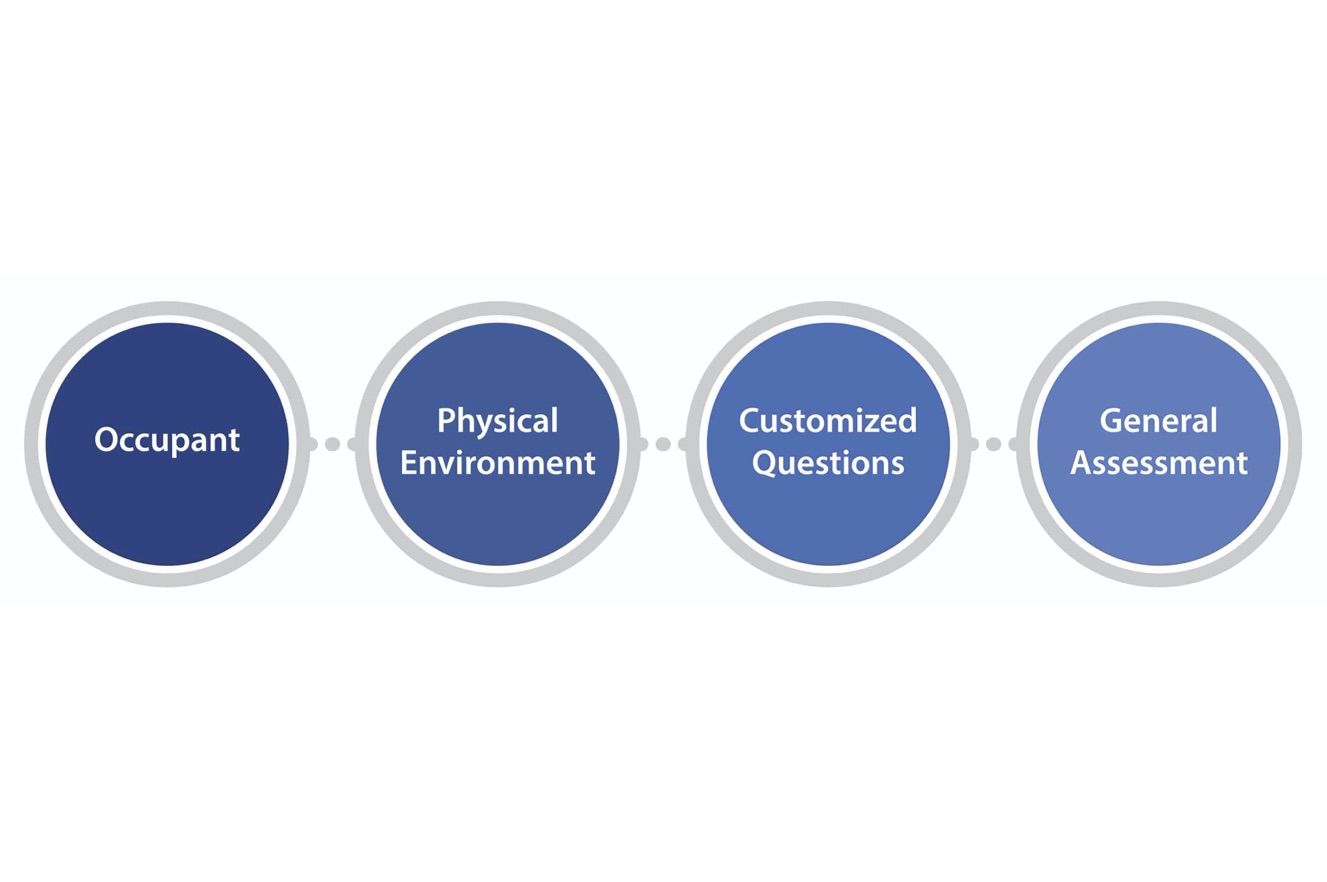
www.buildingsandcities.org/insights/news/occupant-surveys.html
What Have We Learnt from 20 Years of Occupant Surveys?

This peer-reviewed paper consolidates lessons from 20 years of post-occupancy surveys
Post-occupancy evaluation (POE) serves an important role in
collecting occupant insights on the performance of a building, understanding
flaws, and establishing ways to improve the indoor environment. Lindsay T. Graham,
Thomas Parkinson and Stefano Schiavon's recent Buildings & Cities
research paper LESSONS LEARNED FROM 20 YEARS OF CBE'S OCCUPANT SURVEY analyses
20 years of data to evaluate the structure and benchmarking metrics of the University
of California Berkeley Center for the Built Environment's (CBE) Occupant
Survey. Using data from over 90,000 respondents from approximately 900
buildings, they reassess whether occupant surveys are evaluating all they need
to, especially following the transformation that workspaces have experienced in
the last two decades.
The general occupant survey structure includes:
- questions on the occupant themselves
- questions on their physical environment
- customized questions that occupants are directed to if they express some degree of dissatisfaction with aspects of their environment
- a general assessment of the overall environment.
Using correlation analysis, Principal Component Analysis and Hierarchical Clustering Analysis, the authors explore: the distribution of participant responses across several Indoor Environmental Quality (IEQ) factors; the structure and measurement properties of the survey; and how benchmarking metrics align with the tool's underlying structure.
Over the entire survey database, the authors find that roughly two thirds of respondents are satisfied with their workspace. Occupants are most satisfied with spaces' ease of interaction, amount of light, and space cleanliness; they are most dissatisfied with sound privacy, temperature, and noise level. In addition to aggregating findings, the authors use their analysis to reflect on the wider practice of POE and make recommendations for developing occupant surveys.
With regard to the survey structure, the authors make a case for streamlining questions. At present individual IEQ factors each have an associated question about whether they enhance or interfere with occupants' ability to complete their job. Instead, they suggest that it should be possible to have just one item that assesses the impact of the space overall on occupants' ability to complete tasks. In addition, the authors' correlation analysis suggests that multiple items around an IEQ theme are not always needed.
Crucially, the authors note that the occupant survey focuses on the problems and limitations within a space, rather than what is working well. They highlight that the survey offers an opportunity for insight into the successful elements of a design and suggest adding questions to capture this. Alongside this, questions that address occupant expectations of the space could be added to help understand the way space impacts emotions and could support occupants to achieve their tasks.
Cross-pollination between building science and social and health sciences could be especially fruitful. Specifically, they suggest incorporating well-developed and tested variables for stress, wellbeing and personality elements. This could be particularly fruitful for monitoring how comfortable people are in workspaces following the Covid-19 pandemic.
The use of workspaces is changing, particularly an increasing prevalence of agile work spaces. POE approaches need to adapt to this. The authors suggest generating shorter, experience-focused surveys utilising smartphones and wearable technologies. They also advocate for pairing this with monitoring of occupancy using sensors to gather a more holistic view of the occupant-building relationship.
The analysis presented in this paper is incredibly useful for truly understanding the utility of the tools that are used for monitoring our built environment such that they can be improved. Changes to the CBE Occupant Survey will be made as a result of this work.
Reference
Graham, L. T., Parkinson, T., & Schiavon, S. (2021). Lessons learned from 20 years of CBE's occupant surveys. Buildings and Cities, 2(1), pp. 166-184. DOI: https://doi.org/10.5334/bc.76
Latest Peer-Reviewed Journal Content
Living labs: epistemic modelling, temporariness and land value
J Clossick, T Khonsari & U Steven
Co-creating interventions to prevent mosquito-borne disease transmission in hospitals
O Sloan Wood, E Lupenza, D M Agnello, J B Knudsen, M Msellem, K L Schiøler & F Saleh
Circularity at the neighbourhood scale: co-creative living lab lessons
J Honsa, A Versele, T Van de Kerckhove & C Piccardo
Positive energy districts and energy communities: how living labs create value
E Malakhatka, O Shafqat, A Sandoff & L Thuvander
Built environment governance and professionalism: the end of laissez-faire (again)
S Foxell
Co-creating justice in housing energy transitions through energy living labs
D Ricci, C Leiwakabessy, S van Wieringen, P de Koning & T Konstantinou
HVAC characterisation of existing Canadian buildings for decarbonisation retrofit identification
J Adebisi & J J McArthur
Simulation and the building performance gap [editorial]
M Donn
Developing criteria for effective building-sector commitments in nationally determined contributions
P Graham, K McFarlane & M Taheri
Reimagining circularity: actions for optimising the use of existing buildings
R Lundgren, R Kyrö, S Toivonen & L Tähtinen
Effective interdisciplinary stakeholder engagement in net zero building design
S Vakeva-Baird, F Tahmasebi, JJ Williams & D Mumovic
Metrics for building component disassembly potential: a practical framework
H Järvelä, A Lehto, T Pirilä & M Kuittinen
The unfitness of dwellings: why spatial and conceptual boundaries matter
E Nisonen, D Milián Bernal & S Pelsmakers
Environmental variables and air quality: implications for planning and public health
H Itzhak-Ben-Shalom, T Saroglou, V Multanen, A Vanunu, A Karnieli, D Katoshevski, N Davidovitch & I A Meir
Exploring diverse drivers behind hybrid heating solutions
S Kilpeläinen, S Pelsmakers, R Castaño-Rosa & M-S Miettinen
Urban rooms and the expanded ecology of urban living labs
E Akbil & C Butterworth
Living with extreme heat: perceptions and experiences
L King & C Demski
A systemic decision-making model for energy retrofits
C Schünemann, M Dshemuchadse & S Scherbaum
Modelling site-specific outdoor temperature for buildings in urban environments
K Cebrat, J Narożny, M Baborska-Narożny & M Smektała
Understanding shading through home-use experience, measurement and modelling
M Baborska-Narożny, K Bandurski, & M Grudzińska
Building performance simulation for sensemaking in architectural pedagogy
M Bohm
Beyond the building: governance challenges in social housing retrofit
H Charles
Heat stress in social housing districts: tree cover–built form interaction
C Lopez-Ordoñez, E Garcia-Nevado, H Coch & M Morganti
An observational analysis of shade-related pedestrian activity
M Levenson, D Pearlmutter & O Aleksandrowicz
Learning to sail a building: a people-first approach to retrofit
B Bordass, R Pender, K Steele & A Graham
Market transformations: gas conversion as a blueprint for net zero retrofit
A Gillich
Resistance against zero-emission neighbourhood infrastructuring: key lessons from Norway
T Berker & R Woods
Megatrends and weak signals shaping future real estate
S Toivonen
A strategic niche management framework to scale deep energy retrofits
T H King & M Jemtrud
Generative AI: reconfiguring supervision and doctoral research
P Boyd & D Harding
Exploring interactions between shading and view using visual difference prediction
S Wasilewski & M Andersen
How urban green infrastructure contributes to carbon neutrality [briefing note]
R Hautamäki, L Kulmala, M Ariluoma & L Järvi
Implementing and operating net zero buildings in South Africa
R Terblanche, C May & J Steward
Quantifying inter-dwelling air exchanges during fan pressurisation tests
D Glew, F Thomas, D Miles-Shenton & J Parker
Western Asian and Northern African residential building stocks: archetype analysis
S Akin, A Eghbali, C Nwagwu & E Hertwich



Latest Commentaries
Building-Related Research: New Context, New Challenges
Raymond J. Cole (University of British Columbia) reflects on the key challenges raised in the 34 commissioned essays for Buildings & Cities 5th anniversary. Not only are key research issues identified, but the consequences of changing contexts for conducting research and tailoring its influence on society are highlighted as key areas of action.
Lessons from Disaster Recovery: Build Better Before
Mary C. Comerio (University of California, Berkeley) explains why disaster recovery must begin well before a disaster occurs. The goal is to reduce the potential for damage beforehand by making housing delivery (e.g. capabilities and the physical, technical and institutional infrastructures) both more resilient and more capable of building back after disasters.